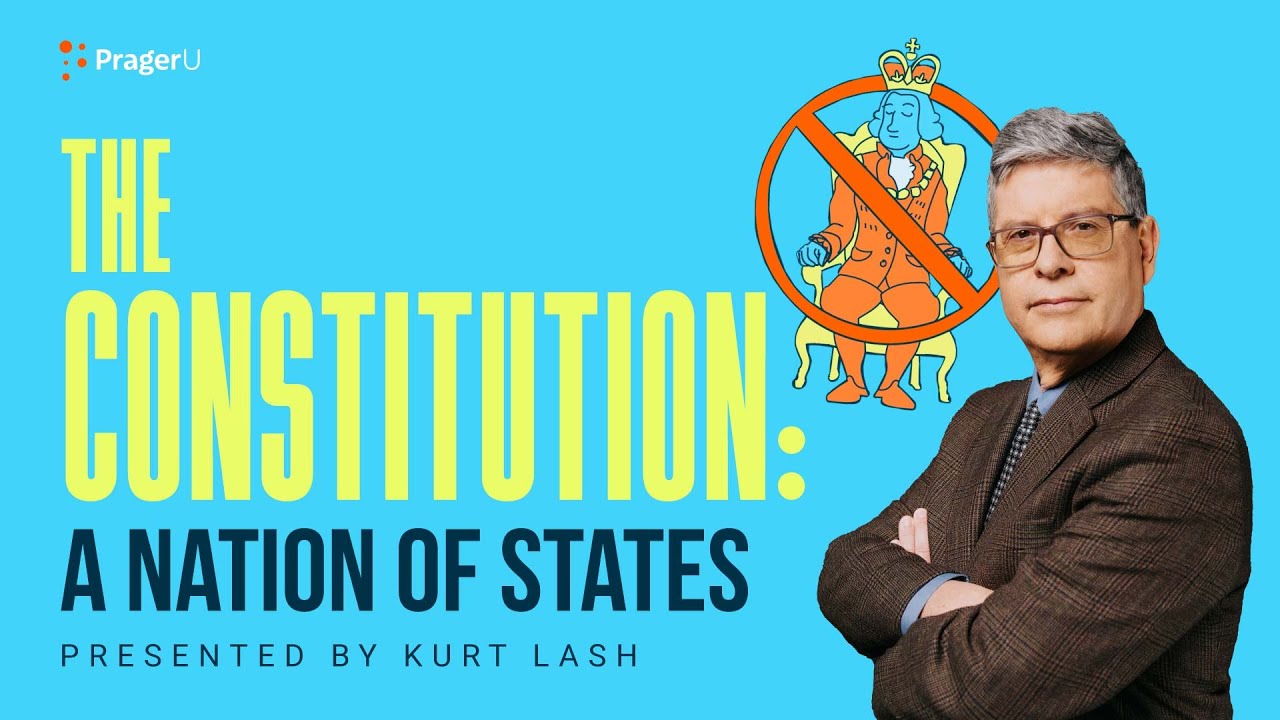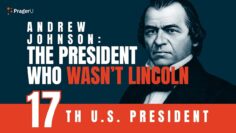
The Constitution: A Nation of States
How did thirteen separate colonies become the United States of America? The answer is found in the second half of the American Constitution—Articles IV through VII. Kurt Lash, Professor of Law at the University of Richmond, explains.
SUBSCRIBE 👉 https://www.prageru.com/join
#constitution #america #prageru #history
Script:
The first half of the Constitution —Articles I, II and III — discuss the powers of the three branches of the national government. The second half of the Constitution — Articles IV through VII — discuss the relationship between the national government and the states.
These four articles don’t get the attention of the first three, but that doesn’t mean they’re any less important.
Let’s take a closer look.
First, Article IV.
When America won the Revolutionary War, the former English colonies became free and independent states—almost as if they were separate countries. But when those states later voted to ratify the federal Constitution, they became part of an indestructible union of states under a common national government, one in which all citizens were granted the same rights.
This seems obvious to us now, but it was new then. As Article IV affirms, “The Citizens of each State shall be entitled to all Privileges and Immunities of Citizens in the several States.”
This gets complicated — as everything did at the time — when the issue of slavery is raised.
Section Two of Article IV declares that “[N]o Person held to…Labour in one State…escaping into another, shall… be discharged from such…Labour, but shall be delivered up [to] the Party to whom such…Labour may be due.”
This is called the Fugitive Slave Clause, though the term “slave” is not used. In fact, you can’t find the word “slave” anywhere in the original Constitution. The Framers were wary about endorsing slavery even though, for political reasons — to keep the Southern states in the Union — they permitted it.
As James Madison explained, it would be “wrong to admit in the Constitution the idea that there could be property in men.”
Article V explains how the Constitution can be amended.
Changing a federal law is simple: it just takes a majority vote in Congress. This happens all the time. Changing the Constitution, however, is much more difficult. It takes a two-thirds majority vote in both the House and the Senate, or a special convention called for by two-thirds of the states.
The proposed amendment must then be ratified by three-quarters of the states.
This deliberately difficult two-stage process ensures that only those amendments with widespread support get to become part of the Constitution.
Article VI ensures that the Constitution is the “supreme Law of the Land.” In other words, every state must obey the Constitution and the laws of the federal government.
Before the Constitution was ratified in 1788, the new nation was organized under what were called the Articles of Confederation. But this governing document proved woefully inadequate. It had no chief executive, no federal court system, and no ability to collect taxes to support the national defense.
The new Constitution addressed all these problems. But it did so in a way that preserved the power of the states to control matters of local concern.
This division of power between the national government and the states is called federalism. Prior to the adoption of the American Constitution, nothing like it had existed in the history of the world. No nation had ever attempted to place these kinds of limits on a central government.
For this new federalist system to work, however, states had to agree to be bound by the new Constitution and federal law. Of course, federalism is a two-way street: Federal officials also had to accept the fact that their powers were limited and that the people in the states retained all powers and rights not constitutionally delegated to the federal government.
That’s why Article VI requires every official in the national government and in the states to take an oath “to support this Constitution.” The Constitution these officials swear to uphold is a federal Constitution of limited and divided power.
For the full script, visit: https://www.prageru.com/video/the-constitution-a-nation-of-states
source











The Indians were here first.
So the constitution doesn’t require religious text, but JESUS said, unless you are born from above, you will not enter, let alone participate in the sovereignty of God, this is why the us government is a secular pagan organization, and no follower of God should have anything to do with it.
It is very clear in the Bible, that stealing is a crime, yet the constitution, which is a pagan religion, doesn’t care what the Bible says.
ALL TAXES ARE THEFT, I GUESS PRAGER DOESN’T KNOW HIS TORAH.
I want to know WHO gave this people the authority to write the constitution and to rule over others.
Our rights come from God, they are granted by any constitution, everything this man says is not true.
The earth belongs to God, not to any state.
The constitution is also a religious document, citizens don’t have to accept it or believe it, it boggles my mind how Prager doesn’t know this.
The constitution is an illegal document, it violates the laws of God, it violates the laws of man, it violates natural laws, and it has no signatures, except of those who wrote it.
All true, sadly though, the federal government is far from properly limited anymore due to an irrational interpretation of the General Welfare clause at the beginning of Article I, Section 8 which assumes the following enumerations to be superfluous.
God bless America! 🇺🇸
Irish were the first in America sighn your name to a piece of paper and your not a slave but a worker who is in debt and a agreement
I published in this in 2016 the title is Handbook for American Conservatives [Amazon Kindle].
NeoCon rubbish. The 13 colonies did become (not "become like") free and independent States in 1783 (Treaty of Paris). They all may have desired a perpetual union, but nobody of the era believed that the Union was indestructible (read the ratification declarations of the States). In fact, the North was the first to openly profess a desire to secede (Hartford Convention of 1814). The Constitution only protected the rights people of the several states from infringement by the federal government (the sovereign States could do as they please). The Constitution was written to constrain the federal government, and as such only those federal laws that fell under the purview of enumerated powers within the Constitution were applicable to the sovereign States. All other powers were reserved to the States (10th Amendment). We, have never been nor will ever be one people. That is Joseph Story fabricating upon the Committee of Style's artful contraction of the "We the People of the States of…" Read Abel P Upshur's critical response to Story's assertion. The notion of one people though is necessary for a national government. Unfortunately our decentralized Jeffersonian federal republic was supplanted by a Lincolnian national empire in 1865; and the SCOTUS through Implied Powers, Incorporation Doctrine, and asserted Supremacy, have run roughshod over the States and their citizens ever since.
"indestructible"?
States do not have to obey the fed if the fed in infringing on constitutional rights which we are seeing with ATF right now.
The constitution? Oh you mean that document that protected the institution of slavery. Throw it out
I enjoyed this video and most of it was spot on, but there were a few factual problems.
“When America won the Revolutionary War, the former English colonies became free and independent states—almost as if they were separate countries.”
There is no almost about it. They were separate countries bound together by the Articles of Confederation. A compelling argument could be made that the states are still separate countries. “State” and “nation” are synonymous.
“when those states later voted to ratify the federal Constitution, they became part of an indestructible union of states ”
The union is not indestructible. Later in the video, you point out states retain all powers not delegated to the federal government. While you don’t mention it, powers can be prohibited to states by the Constitution, but the Tenth Amendment clearly states:
“The powers not delegated to the United States by the Constitution, nor prohibited by it to the states, are reserved to the states respectively, or to the people.”
The power to prevent secession is not so delegated to the federal government and secession is not prohibited to the states in the Constitution.
If states cannot leave this union they entered voluntarily, that would negate the most basic principle on which these United States were founded.
As the Declaration of Independence tell us, “Governments are instituted among Men, deriving their just powers from the consent of the governed,—That whenever any Form of Government becomes destructive of these ends, it is the Right of the People to alter or to abolish it, and to institute new Government…”
When you say, “Article VI ensures that the Constitution is the “supreme Law of the Land.” In other words, every state must obey the Constitution and the laws of the federal government, ” you leave out “This Constitution, and the laws of the United States which shall be made in pursuance thereof… shall be the supreme law of the land”. Only federal laws that follow the Constitution must be obeyed by the states. Madison and Jefferson championed nullification of unconstitutional federal laws.
Finally, when you say, “On June 21, 1788, New Hampshire became the ninth state to ratify the Constitution.”
“That date marks the moment that the people of the several states transformed themselves into the people of the United States of America.”
After New Hampshire became the ninth state to ratify the Constitution, the Confederation Congress set March 4, 1789 for the Constitution become official. Prior to that date, two additional states ratified the Constitution, bringing the total to eleven. So, on March 4, 1789, were two states dragged unwillingly under the authority of the Constitution? No. On March 4, 1789, the United States consisted of eleven states. North Carolina and Rhode Island were completely independent with no association with the United States.
How did that come about? There was no provision to expel states in the Articles of Confederation. So either those eleven states seceded and formed a new United States or the United States disbanded and formed a new United States. Since North Carolina and Rhode Island did not continue to meet under the Articles of Confederation, the implication is the United States disbanded and formed a new United States under the Constitution. Both states later joined the new United States so most of us are unaware of this peculiar beginning.
Does this guy have a learning disability?
Make the government obey the Constitution again.